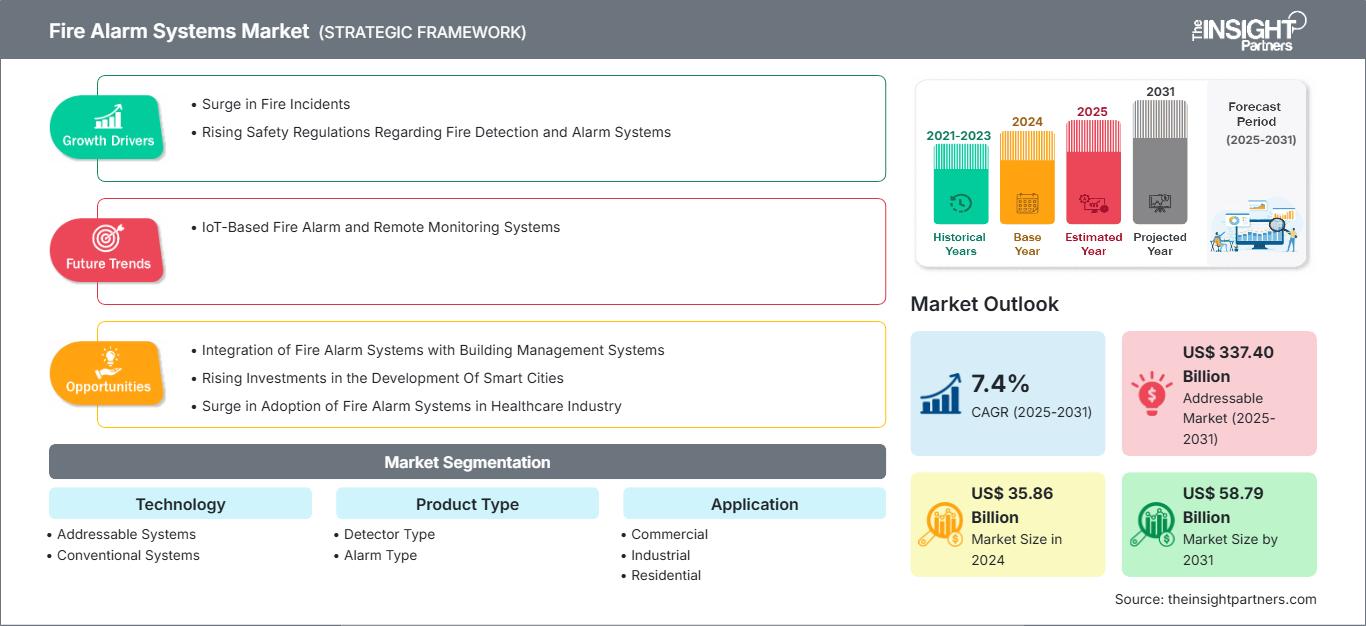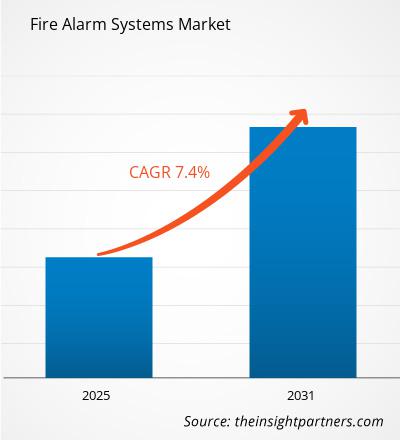预计到 2031 年,火灾报警系统市场规模将从 2024 年的 358.6 亿美元增至 587.9 亿美元。预计该市场在 2025 年至 2031 年期间的复合年增长率为 7.4%。基于物联网的火灾报警和远程监控系统可能会在未来几年为市场带来新的趋势。
火灾报警系统市场分析
由于火灾事故数量的增加,预计火灾报警系统市场在预测期内将出现显著增长。例如,根据美国国家消防协会 (NFPA) 的数据,2022 年美国地方消防部门应对了约 150 万起火灾。这些事故造成 3,790 名平民死亡,13,250 名平民受伤。这些火灾造成的财产损失预计为 180 亿美元。由于火灾事故频发,多个国家的政府正在实施严格的措施,在住宅、商业和工业场所安装火灾报警系统,这推动了市场的增长。
为了提高效率并提供更安全的建筑环境,各公司正致力于将火灾报警系统与楼宇管理系统 (BMS) 集成。此外,关于火灾探测和报警系统的安全法规日益严格,以及医疗机构越来越多地采用火灾报警系统,预计将在未来几年为市场参与者带来大量机遇。此外,物联网 (IoT)、视频烟雾探测和远程监控等技术的融合,预计将在不久的将来为市场增长带来新的趋势。
火灾报警系统市场概览
火灾报警器通常安装在火灾报警系统中,为住宅和商业物业提供区域覆盖。警报信号可能包括响亮的警报器/铃声、闪光灯或两者兼有。一些火灾报警系统还提供额外的警告,例如语音消息或电话。大多数先进的火灾报警系统都采用无线技术和智能设备,通过远程控制面板来保护和管理自动化建筑;例如,可以在智能手机上下载、安装和维护的移动应用程序。
自定义此报告以满足您的要求
您将免费获得任何报告的定制,包括本报告的部分内容,或国家级分析、Excel 数据包,以及为初创企业和大学提供超值优惠和折扣
火灾报警系统市场: 战略洞察

- 获取本报告的主要市场趋势。这个免费样本将包括数据分析,从市场趋势到估计和预测。
您将免费获得任何报告的定制,包括本报告的部分内容,或国家级分析、Excel 数据包,以及为初创企业和大学提供超值优惠和折扣
火灾报警系统市场: 战略洞察

- 获取本报告的主要市场趋势。这个免费样本将包括数据分析,从市场趋势到估计和预测。
火灾报警系统市场驱动因素和机遇
有关火灾探测和报警系统的安全法规数量增加
火灾相关危险会导致生命和宝贵资产的损失,促使政府当局制定有关火灾探测和报警系统的严格规章制度。这些法规通常要求在住宅、商业和工业建筑中安装火灾探测系统,以确保公共安全并防止火灾相关灾害。例如,在日本,《消防法》规定,建筑面积超过规定阈值的建筑物必须安装自动火灾探测系统。阿联酋实施了一项新法规,要求自2024年1月起在所有住宅建筑中安装火灾报警器。此外,火灾报警系统中视觉信号装置标准DIN EN 54-23的规定在德国具有法律约束力。随着政府和监管机构实施更严格的消防安全规范和标准,对合规火灾报警系统的需求正在增加。此外,随着各国大力推进更智能、更互联的基础设施建设,将火灾报警系统与物联网和自动化等先进技术相结合已成为这些法规的一部分。这种整合推动了先进火灾报警系统的创新和应用,从而促进了整体市场的增长。
建筑活动增加
沙特阿拉伯、印度和法国等国家正在启动多个基础设施项目,包括新铁路项目、特大城市、港口、机场和住房项目。以下列出了一些大型建筑项目:
- 洛杉矶计划举办2028年夏季奥运会。随着这一宣布,新设施建设于 2023 年开始,预计将于 2028 年上半年完工。这个庞大项目的重点是为参与者建造住房和设施。
- 2024 年 9 月,沙特阿拉伯为房地产建设和基础设施项目提供了 1.3 万亿美元的资金,以实现经济对石油的多元化,住宅单元超过 100 万套。
- 2025 年 1 月,法国总统埃马纽埃尔·马克龙宣布了世界上参观人数最多的博物馆——巴黎卢浮宫的新修复和扩建项目。
- 2025 年 1 月,总部位于班加罗尔的 Brigade Group 敲定了一项最终协议,将在 Whitefield-Hoskote 路上收购一块 20 英亩的土地,用于一个新住宅项目,预计总开发价值 (GDV) 为 270 亿印度卢比。
火灾报警系统有助于探测建筑物或任何其他封闭空间内是否存在火灾或烟雾,并警告人们。因此,预计在预测期内,对智慧城市发展的投资激增将为市场增长创造丰厚的商机。
火灾报警系统市场报告细分分析
促成全球火灾报警系统市场分析的关键细分是技术、产品类型和应用。
- 基于技术,全球火灾报警系统市场分为可寻址系统和传统系统。可寻址系统细分在 2024 年占据了市场主导地位。
- 按产品类型,全球火灾报警系统市场分为探测器类型、警报类型和控制面板。探测器类型细分进一步分为烟雾探测器、热探测器、火焰探测器等。警报类型细分又细分为声音警报、视觉警报和手动呼叫点警报。 2024 年,探测器类型占据了最大的市场份额。
- 在应用方面,全球火灾报警系统市场分为商业、工业和住宅。2024 年,商业领域占据了市场主导地位。
按地域划分的火灾报警系统市场份额分析
全球火灾报警系统市场分为五大区域:北美、欧洲、亚太地区、中东和非洲 (MEA) 以及南美。2024 年,北美占据了市场主导地位。
通过经济、商业和住宅合作、一体化和政策协调,北美的经济竞争力持续增强。由于建筑行业的各种投资,这些国家的住宅和商业建筑建设正在增长。例如,2023 年 10 月,全球工程和建筑公司 Fluor 完成了拜耳在加州伯克利投资 2.5 亿美元的制药厂的建设。此外,2024年10月,墨西哥总统宣布了住房和正规化计划,旨在其执政期间建造100万套住房并发放100万份契据。
火灾报警系统市场报告范围
火灾报警系统市场新闻和最新发展
全球火灾报警系统市场的评估是通过收集一手和二手研究后的定性和定量数据进行的,这些数据包括重要的公司出版物、协会数据和数据库。全球火灾报警系统市场的一些发展如下:
- 全球消防系统制造商和供应商Fike Corporation宣布其最新的火灾探测解决方案之一Fike Fire Watch获得全球FM认证。 FM Global 在其数据表 10-3 热工作业管理中推荐了这种便携式火灾监视系统。
(来源:Fike Corporation,新闻稿,2024 年 10 月)
- 霍尼韦尔推出了第一款配备 UL 认证的自测烟雾探测器的火灾报警系统,该系统可以自动测试,从而改变了火灾和生命安全系统的安装、测试和维护方式。带有自检探测器的 NOTIFIER INSPIRE 火灾报警系统旨在通过提高设施管理人员对系统需求的认识,同时为服务提供商配备数字化自检工具,以简化维护工作并支持法规遵从性和系统正常运行时间,从而帮助创建更安全的建筑环境。
(来源:LG 电子,新闻稿,2023 年 3 月)
火灾报警系统市场报告覆盖范围和可交付成果
“全球火灾报警系统市场规模和预测(2021-2031 年)”提供了涵盖以下领域的详细市场分析:
- 全球火灾报警系统市场规模以及各区域和国家/地区涵盖范围内所有关键细分市场的预测
- 全球火灾报警系统市场趋势以及市场动态,例如驱动因素、限制因素和关键机遇
- 详细的 PEST 和 SWOT 分析
- 全球火灾报警系统市场分析,涵盖关键市场趋势、区域框架、主要参与者、法规和最近的市场发展
- 行业格局和竞争分析,涵盖市场集中度、热图分析、知名参与者以及全球火灾报警系统市场的最新发展
- 详细的公司简介
火灾报警系统市场区域洞察
The Insight Partners 的分析师已详尽阐述了预测期内影响火灾报警系统市场的区域趋势和因素。本节还讨论了北美、欧洲、亚太地区、中东和非洲以及南美和中美洲的火灾报警系统市场细分和地域分布。
火灾报警系统市场报告范围
| 报告属性 | 细节 |
|---|---|
| 市场规模 2024 | US$ 35.86 Billion |
| 市场规模 2031 | US$ 58.79 Billion |
| 全球复合年增长率 (2025 - 2031) | 7.4% |
| 历史数据 | 2021-2023 |
| 预测期 | 2025-2031 |
| 涵盖的领域 |
By 技术
|
| 覆盖地区和国家 | 北美
|
| 市场领导者和主要公司简介 |
|
火灾报警系统市场参与者密度:了解其对业务动态的影响
火灾报警系统市场正在快速增长,这得益于终端用户需求的不断增长,而这些需求的驱动因素包括消费者偏好的不断变化、技术进步以及对产品优势的认知度不断提高。随着需求的增长,企业正在扩展产品线,不断创新以满足消费者需求,并抓住新兴趋势,从而进一步推动市场增长。

- 获取 火灾报警系统市场 主要参与者概述
- 历史分析(2 年)、基准年、预测(7 年)及复合年增长率
- PEST和SWOT分析
- 市场规模、价值/数量 - 全球、区域、国家
- 行业和竞争格局
- Excel 数据集
近期报告
客户评价
购买理由
- 明智的决策
- 了解市场动态
- 竞争分析
- 客户洞察
- 市场预测
- 风险规避
- 战略规划
- 投资论证
- 识别新兴市场
- 优化营销策略
- 提升运营效率
- 顺应监管趋势




















 获取免费样品 - 火灾报警系统市场
获取免费样品 - 火灾报警系统市场